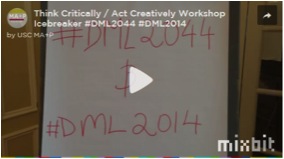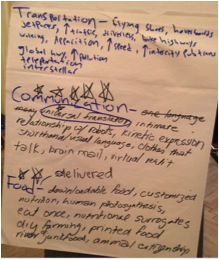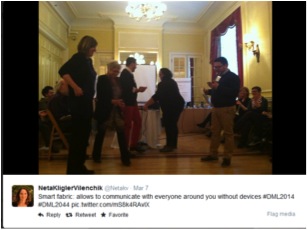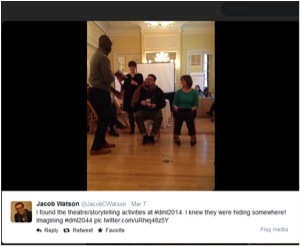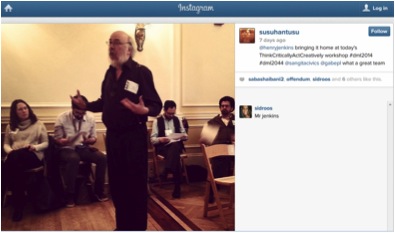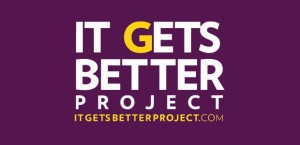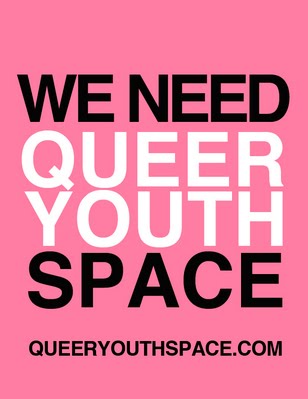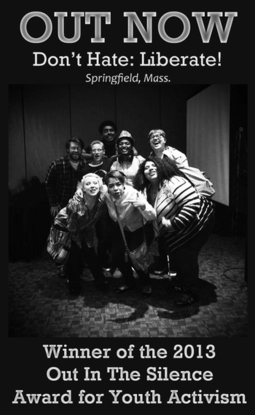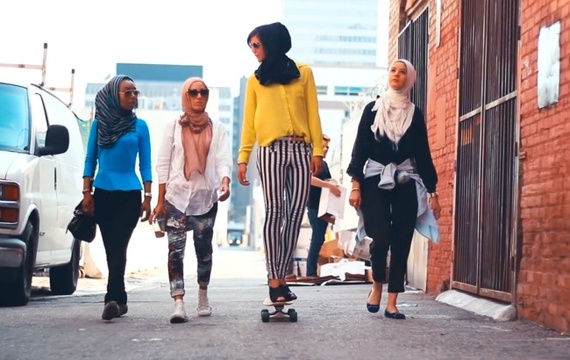Overview
Contributed by Liana Gamber-Thompson
It’s been almost a year since we published our last Hot Spot, a collection of mini-blog posts organized around themes that cut across the diverse interests of participants in our research group. As the membership of Civic Paths changes and expands, we continue to experiment with new forms of scholarship that help put those varied viewpoints in conversation and allow us to work through ideas in a fairly informal way. This time around, we are publishing the results of an email exchange started last Fall in which participants discussed examples of times when social media was used to disrupt traditional power relations between individuals and established institutions, as well as some of the potential drawbacks, challenges and puzzles presented by such a model.
After a period of deliberation, the group chose to write on this prompt, penned by Neta:
This week I watched the movie “Chef,” a very adorable depiction
of a once-successful chef, whose creativity is restrained by the
traditionally-leaning owner of the restaurant he works at. When a food critic
bashes the Chef, their public confrontation spreads online, and the Chef’s
instant Twitter-fame is translated into a successful independent food-truck
business.
The movie seemed to me as another representation of the
power of social media to upheave the traditional power relations between
individuals (such as the Chef) and established institutions (in this case,
restaurants and traditional methods of advertising).
As a first question, what are examples you think of in
regards to the role of social media in changing power relations between
individuals and established institutions?
Raffi started us off with his discussion of how his research interests in minority representations and today’s celebrity culture both places social media in a position of accountability and opens specific spaces for varied user/creator practices. Sam, who Raffi called on to respond, offered some insight into the world of webcomics as one such case of specific online spaces and practices. I should explain here that, under the agreed upon rules of this Hot Spot, any Civic Paths participant could be “challenged” (or invited or encouraged) to respond by the last poster–and there were penalties for not complying! If a “challenged” member of the group failed to respond, they agreed to bring freshly baked, homemade treats for the whole group (no Trader Joe’s cheating allowed!).
Everyone kept their word (no treats for us), and the chain of responses grew. Michelle followed Sam’s challenge, discussing how her experience of following the Michael Brown grand jury decision and its consequences on radio, cable news, and on-site protester livestreaming intimated a different understanding of the publics that form and follow breaking news via social media.
Kjerstin goes on to discuss the politics around visibility and the many contingencies that now shape such individual experiences of political events. Neta argues that social media has changed Benedict Anderson’s famous conception of imagining from communities (nation) to individualities (profiles attached to every like and tweet). Nathalie focuses more concentratedly on the power relations and institutional oppressions that backgrounds communication channels like social media. Finally, Nick argues beyond the mass versus social media binary to ask who makes up the social media space and where is transformative action taking place.
It’s amazing the insights that can be drawn from this kind of academic game of telephone, and we hope you enjoy reading. As always, we also encourage you to add your own thoughts, picking up where the conversation leaves off, in the comments section below.
On Celebrity Culture, Accountability, and User Practices
Contributed by Raffi Sarkissian
With such an effectively broad prompt, there is no shortage of directions this discussion can follow. To get started, though, I will get specific and draw first from my own research interests and hopefully build multiple entry points for responses.
There are actually two tracks of thought that came to mind when thinking about social media’s role in the changing power relations between individuals and established institutions, both related to entertainment media. The first stems from my interest in studying minority images and narratives in popular culture – more specifically, how (and now the varying spaces where) representations of race, gender, class, and especially sexual/gender identity are constructed, mediated, interpreted, and utilized by both dominant institutions and the public.
We can’t really talk about the power of social media without also addressing celebrity in its traditional and evolving iterations (think terms like micro-celebrity, followers, “Youtube star,” etc.). To keep things simple, though, my first example involves taking traditional celebrities (for my purposes this means movie stars, athletes, etc.), as established institutions and how social media does wield a certain amount of power in altering their behaviors and image-management. When Jared Leto won the Golden Globe in 2014 for playing a transgender character in Dallas Buyers Club, his acceptance speech, which included jokes about body transformations and failed to acknowledge either the trans* or AIDS community, was immediately taken to task by various bloggers (including industry trades, grassroots trans/queer communities, and those in-between). While most of the ensuing debate took place in niche social media spaces, what arguably resulted were a string of follow-up acceptance speeches by Leto (for SAG, Independent Spirit, and Oscars) that more consciously addressed what he was critiqued for.
The Jared Leto example is just one in many in recent years relating to flack, accentuated by a groundswell of participation on social media, in regards to homophobic and transphobic remarks made by stars, athletes, music artists, etc., often on Twitter, for which they consequently are pressured to backtrack, apologize and/or coordinate with GLAAD to repair any PR damage. The trend of critical feedback from the public through social media (though, sometimes undoubtedly fanned by various influential players) of course extends beyond political correctness on LGBTQ issues and into any topic, often including Politics. The larger concept at hand is accountability.
Accountability perhaps most traditionally or directly addresses the relationship between politicians and their constituents. And so, I use that term strategically in the discussion of celebrity as our social media age has certainly helped further blur an already loose distinction in the second half of the twentieth century between stars and politicians, between civic actors and famous people, between entertainment and Politics. With increased modes of public scrutiny, celebrities and public figures in an era of heightened “reality” culture are held to be more accountable (in whatever meaning that may take). As social media has changed the dynamics of celebrity and fame, it has also changed along with it larger functions of accountability from the trivial (celebrity feuds) to the institutionally effecting (Occupy).
Now, while this first track has mostly considered individuals (celebrities, politicians) as stand-ins for established institutions, the second track I had in mind concerns the impact of social media (broadly conceived here as tools and platforms that invite participation and connecting with others) on the practices of larger economic entities. More precisely, how social media is used to undermine the power of those established institutions by modes of audience interaction and the spread of amateur production practices. In this arena, what we mostly hear of in the mainstream are the impossible success stories (Justin Bieber, “Fifty Shades of Grey,” Issa Rae) and less on how the spaces these exceptions came from are the sites where shifts in power or power relations are taking place.
My familiarity is mostly with the television industry that seems to have adapted well (for now) to such shifts by adopting social media strategies (virality as promotion, live-tweeting as attempt to bring back appointment television). The dominance and resiliency of the industry, however, should not necessarily overlook the fact that key economic models (promotion, distribution, production, and especially evaluating success) have drastically changed in no small part due to how audiences are sharing, tweeting, making media. A tangentially related industry that is almost never addressed in larger discussions of social media practices is porn. Much like Hollywood, though, the porn industry deals mostly (but not exclusively) with visual media, and ever since moving online has had to adapt to its audience’s consumption practices. Amateur porn now thrives on social media, utilizing video sharing and microblogging platforms to spread (free) content. I’m curious how this affects such a purchase/subscription-based market. I don’t study the porn industry, and thus I cannot conclude on how much impact social media trends have had on the industry’s economic model, but I’m interested to see what other spaces and institutions anyone else has observed similar shifts resulting from both user/consumer and producer practices.
Following, I invite other participants to respond to this discussion thread either directly to some of the ideas I put on the table (accountability, confluence of celebrity culture and Politics, audience/producer practices via social media) or open up other areas of thought. Top
Making a Case with Webcomics
Contributed by Samantha Close
Webcomics, which for me here means comics posted online as their creators’ primary mode of distribution, are one of those spaces of shifting power dynamics you mention. Exceptional success stories, like XKCD creator Randall Munroe’s vault into the number one spot on the New York Times Bestseller List or Order of the Stick creator Rich Burlew’s $1.2 million in Kickstarter donations, are fairly well-known. What is less well known is the way creators, fans, and the various arms of the print comics industry are re-negotiating what had been an infamously rigid production system. And that the webcomics arena is home for a thriving sub-genre of porn.
Or, at least, people won’t admit to knowing about naughty comics online. The primary model of support for webcomic artists has been merchandise sales, through online stores, or Kickstarter and Patreon donations from fans, with spreadability as a key mechanic. Creators build up audiences via social media shares, fan appropriations, and memetic mutations of their images. Micro-payments, whereby each comics viewer pays a very small amount of money to view each comic, largely failed while donations, often publicly acknowledged or rewarded by swag, succeeded. But not for porn. Most of these comics are subscription-only behind a paywall, which cuts against the emerging business model for the rest of the form. As Rob Balder, writer of webcomic Erfworld, said in a panel on financing webcomics, “no one wants to walk around wearing a t-shirt that says ‘I watch porn.'” There are clear limits on what people want their real names to be associated with online, particularly when that linkage itself has the potential to be shared across databases.
But they still support it. And porn comics creators have a seat on the panels with webcomic artists and writers from genres across the board. From my vantage point, what’s happening in comics with the rise of social media is a growing appreciation among the audience for the craft skills of making solid artistic work. Sure there’s plenty of pornographic comics and art on the web for free, but there aren’t necessarily plenty that have that special something a reader needs. Audiences are showing that in a world with an over-abundance of art, they’re willing to support creators who make work that moves them. This isn’t a model that lends itself to those blockbuster success cases, where the goal is wide appeal and massive spread. It is one that supports a myriad of communities growing around and through art that is relevant to them. In other words, if you want to read about the challenges of oral sex while deaf, I’ve got a comic for you. Top
Livestreaming and its Publics
Contributed by Michelle C. Forelle
I want to come back to a point about accountability that Raffi made. Earlier this week, I rushed home from campus in order to be home in time to hear the announcement of the grand jury results in the case of Darren Wilson, a policeman who killed a young black man, Michael Brown, in Ferguson, MO. I was able to hear the announcement live through public radio, and read real-time analyses of its language via Twitter, but what was most remarkable about that night for me is where I watched the consequences of its announcement. While my partner streamed CNN on his laptop, we watched a livestream being recorded on the cell phone of a protestor, on mine. I’ll give you one guess as to whose coverage came across as more knowledgeable and accurate.
The cameraman was Bassem Masri, a vocal Ferguson activist. I was one among an audience of 90,000 watching the demonstrations unfold from Masri’s viewpoint. Although often characterized by news media as an agitator, Masri remained calm over the course of the few hours I watched his livestream, offering lost activists directions, cautioning bystanders to move away from a police car in flames, and just generally describing what he was seeing around him. He had some choice words for the news camera crews that seemed to inevitably focus on either themselves or the rare spots of high tension at the demonstrations.
The livestream itself is only arguably a form of social media; the website Masri used provided a chat window next to the video stream, but the chats were largely one-off comments, overwhelmingly racist and almost entirely incendiary, with little interaction between the chatters. However, the link for this particular livestream was being shared widely over my social media networks. This example suggests that, while social media play an important part in challenging existing power structures by allowing for the circulation of information and the creation of publics around that information, their power is greatly magnified by media production technologies now available to ordinary citizens that allow for the creation of new or alternative sources of information. This is particularly important in situations where the existing power structures are deeply entrenched and can respond oppressively, even violently, to criticism. I am mindful of Katy Pearce’s work in Azerbaijan here, as well as recent events in Hong Kong, which illustrate what can happen if these established institutions get wise to such activist tactics and work pro-actively to cut them off or co-opt them for their own ends. However, at least in the case of the US, I am somewhat encouraged by recent Supreme Court decisions that, to an extent, protect citizen’s rights to use their devices in these ways.
Furthermore, to call back Sam’s point about alternative funding models for emerging media, it’s interesting to note that Masri punctuated his livestream with reminders to his audience that he was funding his livestream using crowdfunding site Fundly, although he offers no details on how the funds would be used. Another crowdfunding site, GoFundMe, was the fundraising tool of choice a couple days later when friends scrambled to raise the $15,000 needed for his cash-only bond after Masri was arrested for driving with a suspended license (he was reportedly in the passenger seat of a friend’s vehicle when the arrest occurred, leading supporters to claim is just the latest form of the extreme police harassment Masri has been experiencing since becoming involved in the Ferguson protests). If we consider these funding sites as social media (which is, again, arguable), then here we have yet another example of how social media can afford popular resistance. Top
Visibility and its Limits
Contributed by Kjerstin Thorson
First off, don’t think I didn’t consider pouring the bucket of water over my head (this is now a metaphor for homemade snacks). But I loved reading about your examples of social(ish) media and opening up opportunities for resistance. Like Michelle, I sat with my family—Happy Thanksgiving, by the way—waiting for the grand jury result in Ferguson. We crowded in the living room and watched CNN because, well, we’re a mainstream media kind of family. I was the only one in the room who was also following the story on Twitter, and thus the only one to see, for example, the floods of criticism of the CNN coverage, or stats going around about how rare it is for a grand jury not to indict (wow), or debates over whether police had or had not used tear gas. I was also the only one in my family to see screen shots of Facebook’s trending topics being passed around on Twitter in a blind grope collective attempt to understand whether the Facebook news feed algorithm was hiding, or at least not highlighting, content about Ferguson. Not for the first time, I found myself obsessing over the many tangled layers of visibility and politics.
When I think about the potential for social media and changing power relations, visibility jumps out as a central puzzle. One consequence of life in a so-called “post broadcast” media environment is the increasing array of contingencies that shape individual experiences of a political event. Algorithms are one piece of the puzzle, but the contingencies are also about personal choices—what you seek out, what you expect to find interesting—as well as who you are connected to, and to what extent you are considered a valuable target by strategic communicators. Given all these contingencies, who sees all this new political activity and for what kinds of people will these emerging forms of activism remain largely invisible? Many of us know that our Twitter feeds will enhance what we can know about an election, a debate, a protest—our media spaces are chockablock with this stuff. We can relate to Michelle’s instinct to watch a livestream as an alternative to cable news. But these uses of social media put us somewhat outside the usual. In one of my favorite recent pieces of understatement, Marc Smith and colleagues in a Pew report about network structures on Twitter wrote, “it is important to remember that the people who take the time to post and talk about political issues on Twitter are a special group” and point out “the relatively modest size of the social networking population who exchange political content in their network” (http://www.pewinternet.org/2014/02/20/mapping-twitter-topic-networks-from-polarized-crowds-to-community-clusters/).
“Relatively modest” indeed. Of course, when we’re talking about the impact of social media on (political) institutions we don’t always need big visibility to make a difference—visibility with the right people can be just as or vastly more important. But I’d love for us to talk about what it might mean—over the long term—that my family “sees” events like Ferguson quite differently than Michelle’s. It seems to me that Raffi’s example of Jared Leto’s slowly changing speeches describes something like a ‘visibility bridge’—one of the topics that drew me to Civic Paths in the first place was the possibility of popular culture as a space for translation between “stuff about politics” and “stuff that people actually enjoy.” Top
Imagined Individuality
Contributed by Neta Kligler-Vilenchik
Thanks so much for your post Kjerstin! I enjoyed reading it and the article you linked is relevant to what I wanted to touch on, though it will come at the end of my little hot-spot journey.
Thinking about the potential of social media in relation to the political realm, I’ve been toying around lately with an idea that I’d be happy to air.
My thought about this concept starts with Benedict Anderson, and his famous term “Imagined Communities”. Anderson, as every graduate student in Communication/Sociology/Political Science will tell you, described the nation as an “imagined community”, “imagined” because “the members of even the smallest nation will never know most of their fellow-members, meet them, or even hear of them, yet in the minds of each lives the image of their communion” (p. 6).
I still remember how ground-breaking I thought this argument was when I first heard it, coming from a country where the nation takes up such a prominent presence in your everyday life.
At first, upon learning about Anderson’s work, I thought its meaning was that the nation is a fiction. But that is not how I interpret the concept today. Contrasting those who have predicted that globalization will make nations obsolete, the nation is alive and kicking, and is causing as much trouble and havoc as ever. “Imagining” has two possible meanings – one of them is conceiving of something that is not real; in the other sense, “imagining” means forming a mental image of something, being able to conceive of it. When Anderson talks about imagined communities, he is talking about the social process that enabled people to conceive of nations as a “thing”.
What makes Anderson’s argument particularly interesting to us as communication scholars is the role of the media, and specifically, the daily newspaper, in bringing about the social process that, in Anderson’s words, “made it possible to ‘think’ the nation.” (p. 22) The reading of the daily newspaper as a form of ritual, Anderson argues, allowed members of the nation to feel like they are exposed to the same information that pertains to them all, and to imagine that others in the nation read about the same events, at roughly the same time they are. In his words, “each communicant is well aware that the ceremony he performs is being replicated simultaneously by thousands (or millions) of others of whose existence he is confident, yet of whose identity he has not the slightest notion.” (p. 35, my emphasis). Anderson’s full argument is of course a lot more complex, but at its basis is the idea that the shared ritual of reading the newspaper was key in being able to imagine other members of your nation, and your (imagined) affinity to them. By extension, this also enabled you to imagine that there are other nations out there, with other people, who aren’t part of your nation.
So where does today’s social media fit in?
The idea I am toying with has to do with how social media allows us to imagine (in the sense of forming a mental image of) not so much “the nation” but, for the first time in history perhaps, the actual identities of many of the specific individuals that it consists of. You might call it, imagined individuality. As Anderson described it, reading the newspaper entailed imagining other people reading it, but we didn’t have any idea about who these people are. We had certain conceptions, based on the people we do know, on mass media depictions etc, but we ever encountered only very few of these people and were able to attach to them a specific name or image.
Ironically, at a time when we are no longer “reading the same newspaper”, and are no longer necessarily exposed to the same information flows (as Kjerstin and Michelle importantly pointed out), we are given a glimpse of the “actual identities” of many individuals. I am thinking of moments of scrolling through my Twitter feed, or seeing comments on photos by friends of friends on Facebook, or browsing Tumblr pages by people I do know. Through social media, we are offered glimpses into the lives, thoughts and views of many, many individuals, who we often don’t know personally, but who – for a brief moment – share some aspect of their lives, be it a funny comment, a recipe, or a political Tweet. We are invited to imagine this fellow human being, who is out there somewhere in the world, who has a name, sometimes attached to a picture or some basic details, and who is living their life at the same time as we are. Potentially, we could even interact with this person (though we rarely do). Whatever this person is sharing is of course only a very specific aspect of who they are, but for a moment, they take on a real presence in our consciousness, as individuals or as members of groups.
Now, this fact may seem trivial, and I don’t think I’ve seen anyone pay attention to it in an explicit sense, but to me it seems that “imagined individuality” has the potential to be quite fundamental, among other things in changing power relations between individuals and established institutions.
One example has to do with our conceptions of “out-groups”, people who perceive as belonging to different groups than us. Rather (or at least, in addition to) having the media, or our school, or our parents, tell us what a certain group is like, we can conceive of them ourselves by getting a glimpse of individuals belonging to that group.
What could be some of the effects of imagined individuality? Being somewhat of an optimist, I think about things like reducing prejudice by imagining the actual people who consist of “out-groups” (a social-media variant of the ‘indirect contact hypothesis’). Then again, we know from articles, like the one Kjerstin linked, that social media networks around political issues tend to cluster into distinct partisan camps, with little communication between them (see also this example about Israeli/Palestinian communication networks during the conflict this past summer https://medium.com/i-data/israel-gaza-war-data-a54969aeb23e).
This may be one space where the translation that Kjerstin hinted at, and that I play around with a lot in my work – the translation between the “cultural” and the political – could come in. Perhaps, when people connect and communicate with others, including members of “out groups”, not around politics but around other issues (the recipe, the comment on the photo) that we may increasingly imagine them as individuals, relate to them as such, and then come to also listen to – and respect – their views when it comes to disagreement and conflict. Perhaps. Top
Institutional Oppression and Counter-Power
Contributed by Nathalie Maréchal
When I first read the prompt, my mind immediately jumped to two pair of definitions, borrowed from Castells, that I’ve used in several projects. Power is “the structural capacity of a social actor to impose its will over other social actor(s)”, while counter-power is “the capacity of a social actor to resist and challenge power relations that are institutionalized” (Castells, 2007, p. 239). Meanwhile, media is the space where power is expressed, while social media (“the media of mass self-communication) is the space where counter-power is expressed.
With these definitions in mind, it becomes obvious that the Internet, and social media specifically, is a game-changer for the relationship between institutions and individuals. The cases cited by the previous discussants on this thread bear this out, at least on the micro level. There are many more cases of individuals (including groups/networks of individuals) voicing their opposition to, or dissent from, institutional power through social media that I’m sure we can all think of. But at the macro level, there’s good reason to worry that the channels through which these voices express themselves might not be available for much longer.
Over the past six months I’ve done a lot of work on forms of institutionalized oppression that are largely invisible to the individual, or not readily identifiable as rights violations in the moment. For example, internet companies’ lack of respect for users’ free expression and privacy rights make them complicit in all manners of human rights violations, but individual instances of censorship or snooping are often experienced as inexplicably slow download speeds, buggy software, mysterious browser errors, or simply not experienced at all. Similarly, the algorithms that determine what content we see on Facebook also fit into these invisible controls. For example, on my own News Feed I hardly saw any egregiously racist discourse around the Brown/Garner grand jury decisions, but there could be any number of reasons that’s the case. The complete absence of bigots from my acquaintance circle is nowhere near the top of the list. To go back to Hong Kong, which Michelle brought up, mainland Chinese Internet users were kept in the dark about the protests in Hong Kong for weeks, and even now are only receiving seriously slanted information. The lack of accurate, timely information is a rights violation, but an invisible one that isn’t even experienced. Yet the fact that the victims aren’t aware that it’s happening doesn’t mean that it isn’t real. To my mind, this is why the fight for net neutrality is so important: to keep the U.S. Internet safe for activism and for access to information, and to avoid setting a horrendous precedent for other countries where America’s bad behavior is used to justify all sorts of terrible things.
I could go on and on with examples and dire warnings, but they all boil down to this. The powerful currently have overwhelming control over the means of communication, and we need to fight to (re)claim it. (I am aware of the Marxist undertones of this phrasing. It is fully intended, though I am still grappling with what that might mean concretely, beyond “censorship bad, activism good.”) Top
The “Who” and “Where” of Social Media Activism
Contributed by Nick Busalacchi
I find this whole “mass media/social media” binary to be woefully unproductive. For one, they’re rather mutually imbricated at this point. Network and cable news outlets retweet user posts and are active on social media; you can’t peruse Facebook or Twitter without some reference to a mainstream article. Also, subversive content is hardly restricted to social media. I find traditionally produced satirical programming to be transformative and subversive, while the bulk of what I read on social media is noise. (Of course, there’s shit on both ends.) Both rely on sensationalism to a large degree. Clickbait is to social media as sensationalist headlines and lead-ins are to mainstream media. On top of this, the political economy of this whole mess is trending toward (#)conglomeration, which is undermining (misguided) populist notions of these platforms in the first place. Now I don’t write this to completely diminish the importance of social media, but instead to beg two questions: “who makes up the social media space?” (both as a public and as a governance structure) and “where is transformative action taking place?”
Re: the who, I rather enjoyed Neta’s connection to Benedict Anderson and her notion of “imagined individuality.” Individual expression made visible through social media is certainly deconstructing the nebulous imaginary of our communities, nations and, well, world. I now have faces, (narrowly constructed) identity profiles and digital traces to more effectively label my fellow Americans–or morally degenerate Tea Partiers. What does it mean that our communities are digital mosaics instead of purely imagined constructions? Is this really (normatively) more desirable? More troubling, if this is the way we view our communities (or individuals in our communities), what does it mean for populations that opt-out, are excluded (e.g., digital divides) or simply, like yours truly, don’t care much about posting content or updating my profile(s)? Lastly, and without getting into a comprehensive neoliberal critique, I find the rat race for individual visibility on social media disturbing and antithetical to community. On Facebook, for example, I do not feel part of a community, but a voice in the crowd shouting “like me, like me” (not very effectively, mind you).
There are, of course, many example of communities that never would have existed but for social media. That is awesome and testament to the positive transformations networked society brings to bear. These communities are valuable in their own right, particularly so when they become agents of change. This brings me to the “where?” To preface, I don’t have much love for the online/offline binary–we live in a hypertext world where everything is simultaneously locally situated and globally connected. Nowhere is this more clear than in contemporary activism. Brown/Garner, Syria, immigrant rights, etc.–all are clear manifestations of digital space interwoven with physical place. That said, I don’t believe true social transformation can reside in digital space. It occurs in the places of everyday life, with the assistance of social media, sure, but also so many other innovative communicative tactics (e.g., die-ins, the Foursquare street art Mike sent out). To address a point Nathalie made, the powerful have ALWAYS had overwhelming control over the means of communication, but we’ve also always found a way to affect incremental change. Social media is at its most revolutionary not as the nagging little sibling of traditional media pushing alternative digital content, but as a component of place-based activism that fuels assembly and creative (and situated!) expressions of resilience. Top



